Information injection-pump assembly
BOSCH
F 019 Z10 243
f019z10243
ZEXEL
106671-8744
1066718744
HINO
220204473A
220204473a

Rating:
Service parts 106671-8744 INJECTION-PUMP ASSEMBLY:
1.
_
7.
COUPLING PLATE
8.
_
9.
_
11.
Nozzle and Holder
23600-2191
12.
Open Pre:MPa(Kqf/cm2)
21.6{220}
15.
NOZZLE SET
Include in #1:
106671-8744
as INJECTION-PUMP ASSEMBLY
Cross reference number
BOSCH
F 019 Z10 243
f019z10243
ZEXEL
106671-8744
1066718744
HINO
220204473A
220204473a
Zexel num
Bosch num
Firm num
Name
Calibration Data:
Adjustment conditions
Test oil
1404 Test oil ISO4113 or {SAEJ967d}
1404 Test oil ISO4113 or {SAEJ967d}
Test oil temperature
degC
40
40
45
Nozzle and nozzle holder
105780-8140
Bosch type code
EF8511/9A
Nozzle
105780-0000
Bosch type code
DN12SD12T
Nozzle holder
105780-2080
Bosch type code
EF8511/9
Opening pressure
MPa
17.2
Opening pressure
kgf/cm2
175
Injection pipe
Outer diameter - inner diameter - length (mm) mm 8-3-600
Outer diameter - inner diameter - length (mm) mm 8-3-600
Overflow valve (drive side)
134424-2020
Overflow valve opening pressure (drive side)
kPa
162
147
177
Overflow valve opening pressure (drive side)
kgf/cm2
1.65
1.5
1.8
Overflow valve (governor side)
134424-2120
Overflow valve opening pressure (governor side)
kPa
162
147
177
Overflow valve opening pressure (governor side)
kgf/cm2
1.65
1.5
1.8
Tester oil delivery pressure
kPa
157
157
157
Tester oil delivery pressure
kgf/cm2
1.6
1.6
1.6
Direction of rotation (viewed from drive side)
Right R
Right R
Injection timing adjustment
Direction of rotation (viewed from drive side)
Right R
Right R
Injection order
1-4-2-6-
3-5
Pre-stroke
mm
4.1
4.04
4.1
Beginning of injection position
Drive side NO.1
Drive side NO.1
Difference between angles 1
Cal 1-4 deg. 60 59.75 60.25
Cal 1-4 deg. 60 59.75 60.25
Difference between angles 2
Cyl.1-2 deg. 120 119.75 120.25
Cyl.1-2 deg. 120 119.75 120.25
Difference between angles 3
Cal 1-6 deg. 180 179.75 180.25
Cal 1-6 deg. 180 179.75 180.25
Difference between angles 4
Cal 1-3 deg. 240 239.75 240.25
Cal 1-3 deg. 240 239.75 240.25
Difference between angles 5
Cal 1-5 deg. 300 299.75 300.25
Cal 1-5 deg. 300 299.75 300.25
Injection quantity adjustment
Adjusting point
A
Rack position
10.7
Pump speed
r/min
1160
1160
1160
Average injection quantity
mm3/st.
212
208
216
Max. variation between cylinders
%
0
-2
2
Basic
*
Fixing the lever
*
Boost pressure
kPa
112
112
Boost pressure
mmHg
840
840
Injection quantity adjustment_02
Adjusting point
B
Rack position
4.5+-0.5
Pump speed
r/min
265
265
265
Average injection quantity
mm3/st.
11.5
8.5
14.5
Max. variation between cylinders
%
0
-15
15
Fixing the rack
*
Boost pressure
kPa
0
0
0
Boost pressure
mmHg
0
0
0
Injection quantity adjustment_03
Adjusting point
C
Rack position
-
Pump speed
r/min
100
100
100
Average injection quantity
mm3/st.
220
220
240
Fixing the lever
*
Boost pressure
kPa
0
0
0
Boost pressure
mmHg
0
0
0
Remarks
Excess lever at excess.
Excess lever at excess.
Boost compensator adjustment
Pump speed
r/min
500
500
500
Rack position
7.7
Boost pressure
kPa
10.7
8
13.4
Boost pressure
mmHg
80
60
100
Boost compensator adjustment_02
Pump speed
r/min
500
500
500
Rack position
(10.7)
Boost pressure
kPa
98.6
98.6
98.6
Boost pressure
mmHg
740
740
740
Timer adjustment
Pump speed
r/min
(N1+50)-
-
Advance angle
deg.
0
0
0
Remarks
Start
Start
Timer adjustment_02
Pump speed
r/min
N1
Advance angle
deg.
0.3
Remarks
Measure the actual speed.
Measure the actual speed.
Timer adjustment_03
Pump speed
r/min
-
Advance angle
deg.
1
0.7
1.3
Remarks
Measure the actual speed, stop
Measure the actual speed, stop
Test data Ex:
Governor adjustment
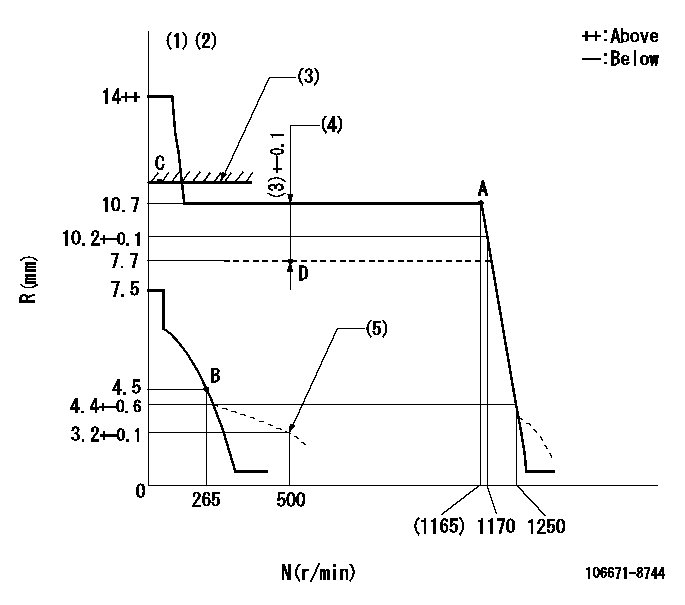
N:Pump speed
R:Rack position (mm)
(1)Target notch: K
(2)Tolerance for racks not indicated: +-0.05mm.
(3)Excessive fuel lever setting (boost pressure 0)
(4)Boost compensator stroke (at N = N1)
(5)Damper spring setting
----------
K=11 N1=500r/min
----------
----------
K=11 N1=500r/min
----------
Speed control lever angle
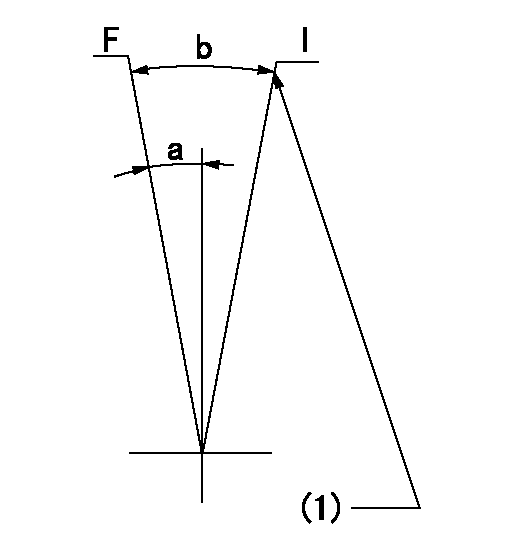
F:Full speed
I:Idle
(1)Stopper bolt setting
----------
----------
a=7deg+-5deg b=31deg+-5deg
----------
----------
a=7deg+-5deg b=31deg+-5deg
Stop lever angle
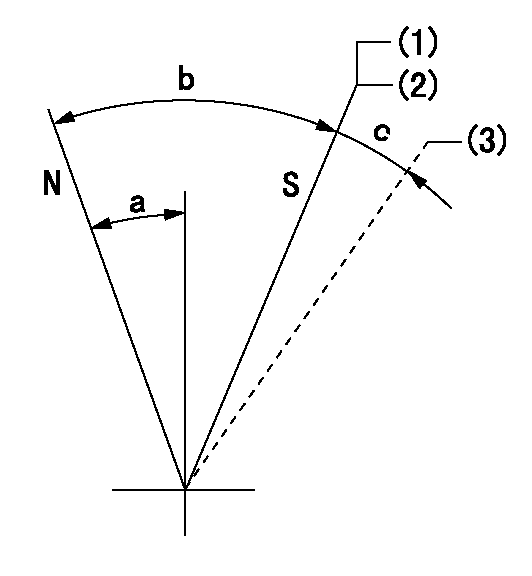
N:Pump normal
S:Stop the pump.
(1)Contacts inner stopper.
(2)Rack position aa or less, pump speed bb
(3)Contacts outer stopper.
----------
aa=4mm bb=0r/min
----------
a=27deg+-5deg b=53deg+-5deg c=(11deg)
----------
aa=4mm bb=0r/min
----------
a=27deg+-5deg b=53deg+-5deg c=(11deg)
0000001101
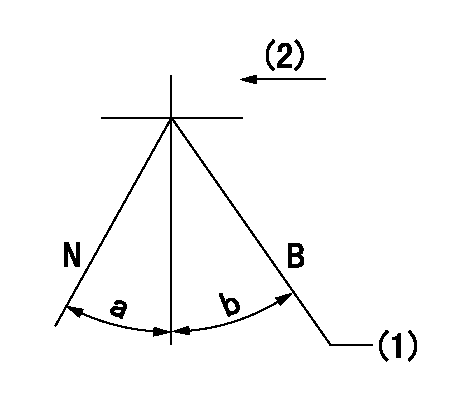
N:Normal
B:When boosted
(1)When setting point C (at 0 boost pressure)
(2)Drive side
----------
----------
a=(15deg) b=(15deg)
----------
----------
a=(15deg) b=(15deg)
Timing setting
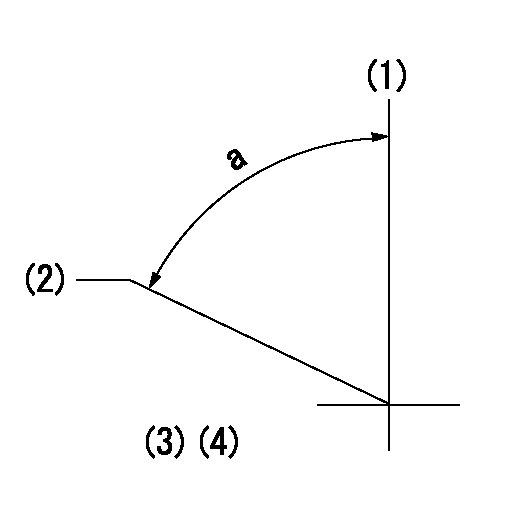
(1)Pump vertical direction
(2)Coupling's key groove position at No 1 cylinder's beginning of injection
(3)-
(4)-
----------
----------
a=(50deg)
----------
----------
a=(50deg)
Information:
Introduction
The problem that is identified below does not have a known permanent solution. Until a permanent solution is known, use the solution that is identified below.Problem
The DOC/DPF can become plugged if an NRS cooler failure occurs and coolant passes out the exhaust. Solution
If an engine has an NRS cooler failure, the DPF and DOC will need inspected for calcium deposits. In some cases calcium has partially filled the DPF and caused frequent regeneration issues, and erratic high soot loading readings.
Illustration 1 g03374496
Example of calcium deposits on DPF face
Illustration 2 g03374497
Example of calcium deposits on DPF faceThe calcium deposits will be a white and black powdery mixture on the face of the DPF and the DOC. Refer to Illustrations 1 and 2 for examples of a DPF with calcium plugging on the DPF face.Refer to Reuse And Salvage Guidelines, SEBF9223, "Inspection of Diesel Particulate Filters and Diesel Oxidation Catalysts for Tier 4 Machine and Industrial Engines" for further assistance.
The problem that is identified below does not have a known permanent solution. Until a permanent solution is known, use the solution that is identified below.Problem
The DOC/DPF can become plugged if an NRS cooler failure occurs and coolant passes out the exhaust. Solution
If an engine has an NRS cooler failure, the DPF and DOC will need inspected for calcium deposits. In some cases calcium has partially filled the DPF and caused frequent regeneration issues, and erratic high soot loading readings.
Illustration 1 g03374496
Example of calcium deposits on DPF face
Illustration 2 g03374497
Example of calcium deposits on DPF faceThe calcium deposits will be a white and black powdery mixture on the face of the DPF and the DOC. Refer to Illustrations 1 and 2 for examples of a DPF with calcium plugging on the DPF face.Refer to Reuse And Salvage Guidelines, SEBF9223, "Inspection of Diesel Particulate Filters and Diesel Oxidation Catalysts for Tier 4 Machine and Industrial Engines" for further assistance.